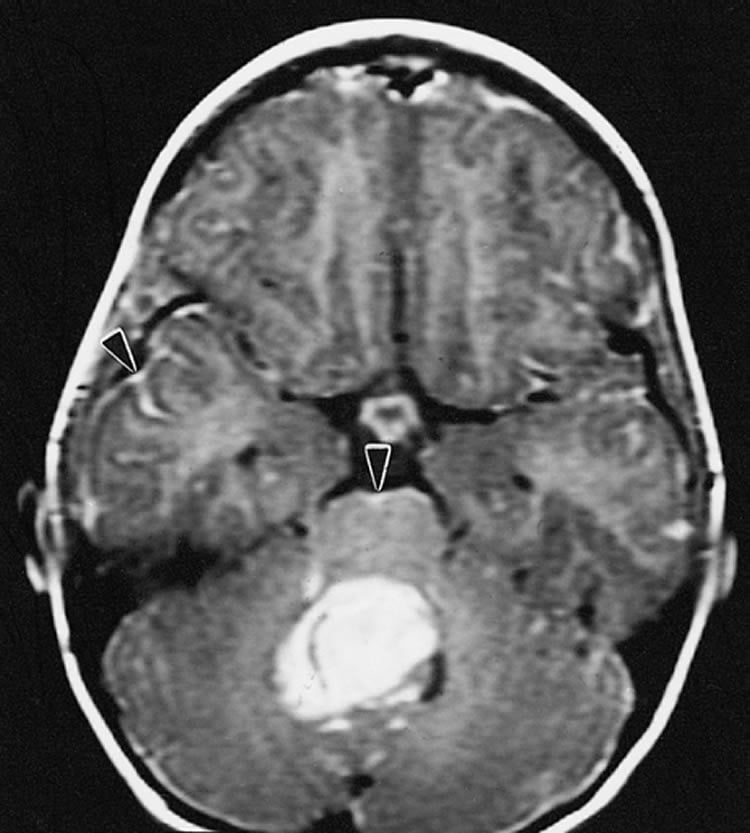A St. Jude Children’s Research Hospital led study identified two adult cancer drugs with potential to improve treatment of a high-risk childhood brain tumor; the drugs are now part of a pediatric clinical trial.
The quest to improve survival of children with a high-risk brain tumor has led St. Jude Children’s Research Hospital investigators to two drugs already used to treat adults with breast, pancreatic, lung and other cancers. The study was published today online ahead of print in the journal Cancer Cell.
Researchers demonstrated that the drugs pemetrexed and gemcitabine killed cells from mouse and human brain tumors, called group 3 medulloblastoma, growing in the laboratory. Medulloblastoma is diagnosed in about 400 children annually in the U.S., making it the most common pediatric brain tumor. Of the four distinct medulloblastoma subtypes, patients with group 3 medulloblastoma have the worst prognosis.
Used together, pemetrexed and gemcitabine doubled life expectancy of mice with human group 3 medulloblastoma, compared to untreated mice. When pemetrexed and gemcitabine were combined with two chemotherapy drugs currently used to treat pediatric medulloblastoma, the mice lived even longer.

The drugs were identified by screening the St. Jude library of 7,389 compounds looking for ones that targeted group 3 mouse tumor cells rather than normal mouse brain cells. The library included all 830 drugs U.S. Food and Drug Administration (FDA) approval. Pemetrexed and gemcitabine emerged as the top candidates, based in part on their ability to kill group 3 medulloblastoma tumor cells at concentrations that researchers showed were safe and achievable in patients.
“Our focus was to identify drugs that we could move quickly from the laboratory to the clinic where new chemotherapy options are desperately needed for these high-risk medulloblastoma patients,” said the study’s corresponding author Martine Roussel, Ph.D., a member of the St. Jude Department of Tumor Cell Biology. “As a basic scientist, it is exciting to be able to translate a laboratory discovery into drugs that are now being used in a clinical trial.”
Based on results from this and previous studies, pemetrexed and gemcitabine were included in a St. Jude-led multicenter clinical trial of children and adolescents newly diagnosed with medulloblastoma. The drugs are already approved for treatment of patients with advanced breast cancer as well as ovarian, pancreatic and certain lung cancers. No safety concerns were identified in previous studies of pemetrexed and gemcitabine for treatment in children with other cancers.
Most group 3 medulloblastoma tumors feature excessive levels of the c-MYC protein, which helps to regulate cell growth. The protein is overexpressed in many cancers and is associated with a poor outcome. About 40 percent of patients with c-MYC overexpression and other characteristics of group 3 medulloblastoma become long-term survivors, compared to 80 percent of other medulloblastoma patients.
“The drugs identified in this study will hopefully close that survival gap and improve cure rates for children with group 3 medulloblastoma,” said co-author Amar Gajjar, M.D., St. Jude Department of Oncology co-chair.
For this study, researchers relied on mice with group 3 medulloblastoma grown from patient tumors. The mice were developed in Roussel’s laboratory and are a powerful tool for testing the effectiveness of drugs against human tumors.
Researchers used the mice to show that pemetrexed and gemcitabine worked against human group 3 tumors and that the drugs could be used in combination with existing chemotherapy agents to boost treatment effectiveness without undue risk. Cisplatin and cyclophosphamide were the other drugs used in this study.
“The finding provides a strong rationale for combination therapy with pemetrexed and gemcitabine for treatment of group 3 medulloblastoma,” Roussel said. Researchers found no evidence that mouse tumor cells develop resistance to the drugs.
Pemetrexed works by disrupting the ability of cancer cells to proliferate. Gemcitabine kills cells by triggering their suicide pathway. Researchers also found evidence the drugs work specifically against group 3 medulloblastoma. The drugs did not extend survival of mice with a different medulloblastoma subtype.
The study builds on previous St. Jude research that has helped to revolutionize understanding of the origins of medulloblastoma and laid the foundation for a new era of risk-based therapy. The goal is to maximize the likelihood of a cure and minimize long-term side effects. The approach combines clinical factors and the molecular markers associated with the different medulloblastoma subtypes to guide how radiation and chemotherapy are combined with surgery.
Marie Morfouace, Ph.D., a postdoctoral fellow in Roussel’s laboratory, is the study’s first author. The other authors are Anang Shelat, Megan Jacus, Burgess Freeman III, David Turner, Sarah Robinson, Frederique Zindy, Yong-Dong Wang, David Finkelstein, Giles Robinson, R. Kiplin Guy and Clinton Stewart, all of St. Jude; Olivier Ayrault and Laure Bihannic, Institut Curie, Orsay, France; Stephanie Puget, Necker-Children Hospital, Paris, France; Xiao-Nan Li, Baylor College of Medicine, Houston; and James Olson, Fred Hutchinson Cancer Center, Seattle.
The research was funded in part by grants (CA096832, CA155360, CA114567, CA021765) from the National Institutes of Health; the French National Cancer Institute; CNRS; Institut Curie; Necker Hospital; the V Foundation and ALSAC.
Contact: Carrie Strehlau – St. Jude Children’s Research Hospital
Source: St. Jude Children’s Research Hospital press release
Image Source: The image is credited to The Armed Forces Institute of Pathology and is in the public domain.
Original Research: Abstract for “Pemetrexed and Gemcitabine as Combination Therapy for the Treatment of Group3 Medulloblastoma” by A Marie Morfouace, Anang Shelat, Megan Jacus, Burgess B. Freeman, David Turner, Sarah Robinson, Frederique Zindy, Yong-Dong Wang, David Finkelstein, Olivier Ayrault, Laure Bihannic, Stephanie Puget, Xiao-Nan Li, James M. Olson, Giles W. Robinson, R. Kiplin Guy, Clinton F. Stewart, Amar Gajjar, and Martine F. Roussel in Cancer Cell. Published online March 27 2014 doi:10.1016/j.ccr.2014.02.009






